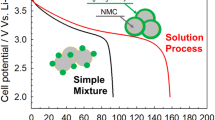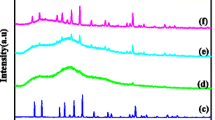Abstract
The central focus of this research work is upon the synthesis of Lix-geopolymers (where x = 0.5 and 0.75) performed with the integration of lithium ions, in order to be used as cathode materials for lithium ions batteries. The obtained results presenting the requirements for these types of materials, demonstrate that Li-geopolymers could stand for a new alternative. The geopolymers were prepared at ambient temperature. The identification phase was carried out by powders X-ray diffraction, after calcination at various temperatures. The thermal stability was investigated by differential thermal analysis up to 1400 °C. With increase of lithium ions insertion, the temperature relative to the evaporation of P2O5 groups increased accompanied by a decrease in the mass loss relative to this phenomenon. The electrical measurements of both samples, were elaborated in the frequency range of 1–106 Hz and at a temperature range of 75–725 °C. After heating at 300 °C, the electrical conductivity values in the Li0.5-geopolymer material, were in the range of 10−6 S cm−1 and 10−4 S cm−1. By increasing lithium ions, the electrical conductivity values of the Li0.75-geopolymer sample, went from 10−7 to 10−5 S cm−1.







Similar content being viewed by others
References
Y. Li, J. Wang, H. Huang, J. Wang, M. Zhang, M. Liang, Co-coating effect of GdPO4 and carbon on LiFePO4 cathode surface for lithium-ion batteries. Adv. Powder Technol. 30(8), 1442–1449 (2019)
Z. Xu, L. Gao, Y. Liu, L. Li, Review—recent developments in the doped LiFePO4 cathode materials for power lithium-ion batteries. J. Electrochem. Soc. 163(13), A2600–A2610 (2016)
P.K. Nayak, et al., Review on challenges and recent advances in the electrochemical performance of high capacity Li- and Mn-rich cathode materials for Li-ion batteries. Adv. Energy Mater. 8(8), 1702397 (2018)
C. Sun, R. Hui, J. Roller, Cathode materials for solid oxide fuel cells: a review. J. Solid State Electrochem. 14(7), 1125–1144 (2010)
S.P. Jiang, Development of lanthanum strontium manganite perovskite cathode materials of solid oxide fuel cells: a review. J. Mater. Sci. 43(21), 6799–6833 (2008)
R. Reinhardt, B. Amante García, L. Canals Casals, S. Gassó Domingo, in Project Management and Engineering Research, ed. by J.L. Ayuso Muñoz, J.L. Yagüe Blanco, S.F. Capuz-Rizo (Springer International Publishing, Cham, 2019), pp. 99–110
D. Li et al., Production of lithium-ion cathode material for automotive batteries using melting casting process’, in 9th International Symposium on High-Temperature Metallurgical Processing, ed. by J.-Y. Hwang, T. Jiang, M.W. Kennedy, D. Gregurek, S. Wang, B. Zhao, O. Yücel, E. Keskinkilic, J.P. Downey, Z. Peng, R. Padilla (Springer International Publishing, Cham, 2018), pp. 135–146
A.K. Padhi, K.S. Nanjundaswamy, J.B. Goodenough, Phospho-olivines as positive-electrode materials for rechargeable lithium batteries. J. Electrochem. Soc. 144(4), 1188 (1997)
J. Yang, J.J. Xu, Synthesis and characterization of carbon-coated lithium transition metal phosphates LiMPO4 (M = Fe, Mn, Co, Ni) prepared via a nonaqueous sol-gel route. J. Electrochem. Soc. 153(4), A716 (2006)
P. Sauriol, et al., Fe 3+ reduction during melt-synthesis of LiFePO4. Can. J. Chem. Eng. 97(8), 2196–2210 (2019)
G. Arnold, J. Garche, R. Hemmer, S. Ströbele, C. Vogler, M. Wohlfahrt-Mehrens, Fine-particle lithium iron phosphate LiFePO4 synthesized by a new low-cost aqueous precipitation technique. J. Power Sources 119–121, 247–251 (2003)
D. Seung-Hyun Lee, W.B. Im, X. Liang, High density conductive LiFePO4 cathode with enhanced high-rate and high temperature performance. J. Mater. Chem. Phys. 232, 367–373 (2019)
L. Lu, X. Han, J. Li, J. Hua, M. Ouyang, A review on the key issues for lithium-ion battery management in electric vehicles. J. Power Sources 226, 272–288 (2013)
H. Lee, et al: Carbon-free Mn-doped LiFePO4 cathode for highly transparent thin-film batteries. J. Power Sources 434, 226713 (2019)
J. Davidovits, Geopolymers: inorganic polymeric new materials. J. Therm. Anal. Calorim. 37(8), 1633–1656 (1991)
D. Cao, D. Su, B. Lu, Y. Yang, Synthesis and structure characterization of geopolymeric material based on metakaolinite and phosphoric acid. J. Chin. Ceram. Soc. 33(11), 1385–1389 (2005)
M. Sellami, M. Barre, M. Toumi, Synthesis, thermal properties and electrical conductivity of phosphoric acid-based geopolymer with metakaolin. J. Appl. Clay Sci. 180, 105–192 (2019)
X. Cui, L. Liu, Y. He, J. Chen, J. Zhou, A novel aluminosilicate geopolymer material with low dielectric loss. J. Mater. Chem. Phys. 130(1–2), 1–4 (2011)
A. Moguš-Milanković, K. Sklepić, P. Mošner, L. Koudelka, P. Kalenda, Lithium-ion mobility in quaternary boro–germano–phosphate glasses. J. Phys. Chem. B 120(16), 3978–3987 (2016)
L. Liu, X. Cui, Y. He, S. Liu, S. Gong, The phase evolution of phosphoric acid-based geopolymers at elevated temperatures. J. Mater. Lett. 66(1), 10–12 (2012)
J.L. Bell, P.E. Driemeyer, W.M. Kriven, Formation of ceramics from metakaolin-based geopolymers: part I-Cs-based geopolymer. J. Am. Ceram. Soc. 92(1), 1–8 (2009)
J. Yuan, et al., Effects of Li substitution on the microstructure and thermal expansion behavior of pollucite derived from geopolymer. J. Am. Ceram. Soc. 99(11), 3784–3791 (2016)
M. Rokita, M. Handke, W. Mozgawa, Spectroscopic studies of polymorphs of AlPO4 and SiO2. J. Mol. Struct. 450(1–3), 213–217 (1998)
J. Temuujin, W. Rickard, M. Lee, A. van Riessen, Preparation and thermal properties of fire resistant metakaolin-based geopolymer-type coatings. J. Non-Cryst. Solids 357(5), 1399–1404 (2011)
J. Temuujin, A. Minjigmaa, W. Rickard, M. Lee, I. Williams, A. van Riessen, Fly ash based geopolymer thin coatings on metal substrates and its thermal evaluation. J. Hazard. Mater. 180(1–3), 748–752 (2010)
O. Bohnké, J.C. Badot, J. Emery, Broadband dielectric spectroscopy study of Li+ ion motions in the fast ionic conductor Li3xLa2/3–xTiO3(x = 0.09); comparison with 7Li NMR results. J. Phys. Condens. Matter. 15(44), 7571–7584 (2003)
S. Poisson, F. dÕYvoire, N.H. Dung, E. Bretey, P. Berthet, Crystal structure and cation transport properties of the layered monodiphosphates: Li9M3(P2O7)3(PO4)2(M = Al, Ga, Cr, Fe). J. Solid State Chem. 138, 32–40 (1998)
Y. Wang, R. Mei, X. Yang, Enhanced electrochemical properties of LiFePO4/C synthesized with two kinds of carbon sources, PEG-4000 (organic) and Super p (inorganic). Ceram. Int. 40(6), 8439–8444 (2014)
C. Kuss, D. Lepage, G. Liang, S.B. Schougaard, Ultrafast charging of LiFePO4 with gaseous oxidants under ambient conditions. Chem. Sci. 4(11), 4223–4227 (2013)
J. Yang, et al., LiFePO4–graphene as a superior cathode material for rechargeable lithium batteries: impact of stacked graphene and unfolded graphene. Energy Environ. Sci. 6(5), 1521–1528 (2013)
Author information
Authors and Affiliations
Corresponding author
Ethics declarations
Conflict of interest
The authors declare that they have no conflict of interest.
Additional information
Publisher's Note
Springer Nature remains neutral with regard to jurisdictional claims in published maps and institutional affiliations.
Rights and permissions
About this article
Cite this article
Sellami, M., Barre, M. & Toumi, M. The New Challenge of Acid-Based Geopolymers Synthesized with the Incorporation of Lithium Ions as Cathode Materials for Lithium-Ion Batteries. J Inorg Organomet Polym 30, 3126–3131 (2020). https://doi.org/10.1007/s10904-020-01475-z
Received:
Revised:
Accepted:
Published:
Issue Date:
DOI: https://doi.org/10.1007/s10904-020-01475-z




